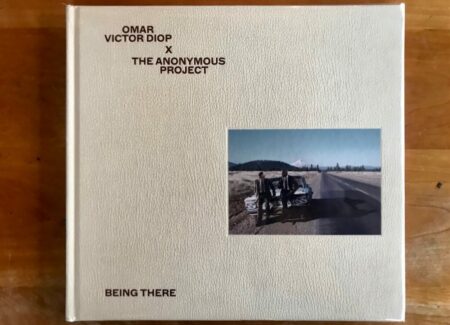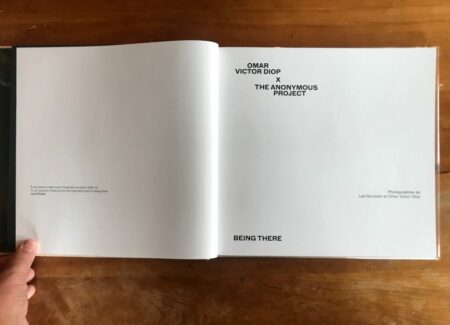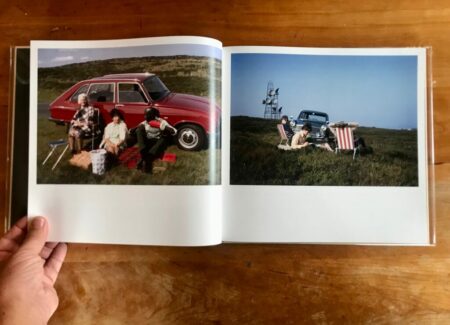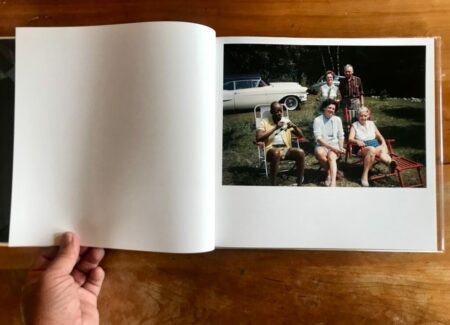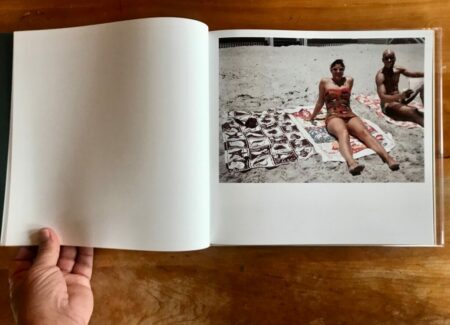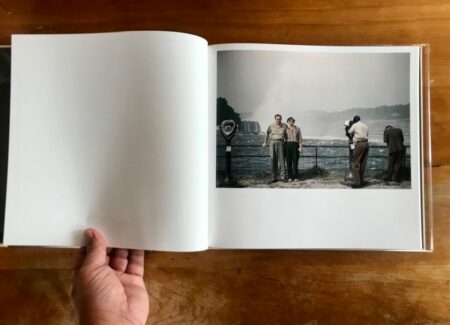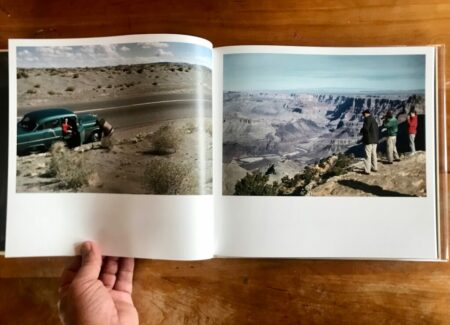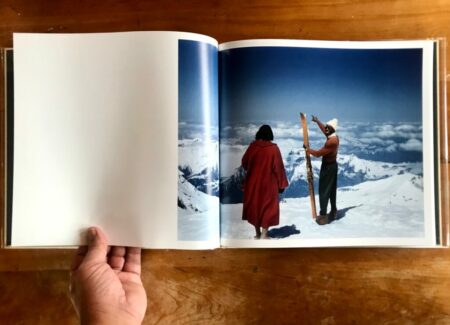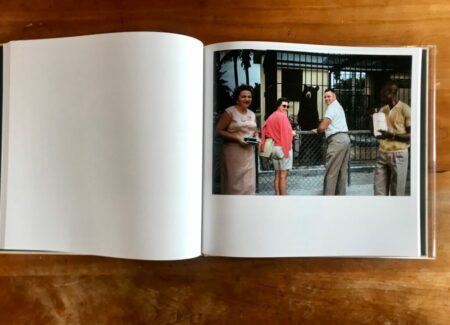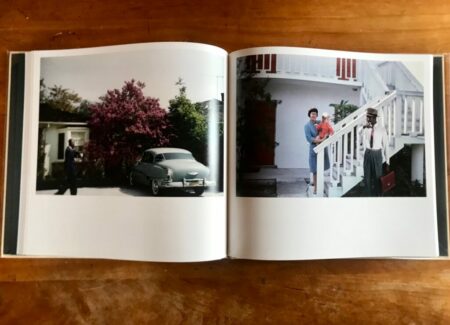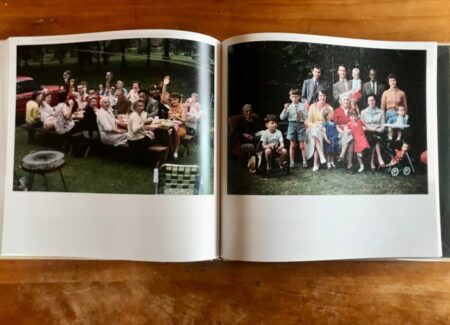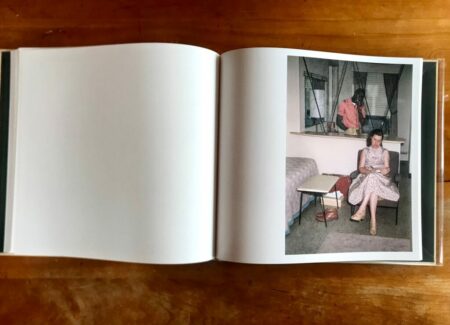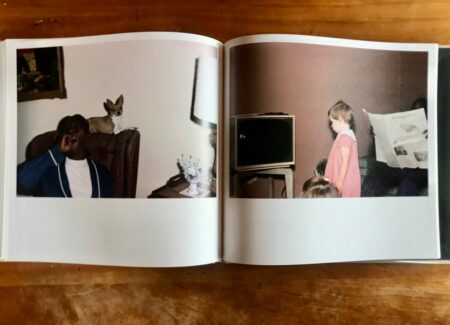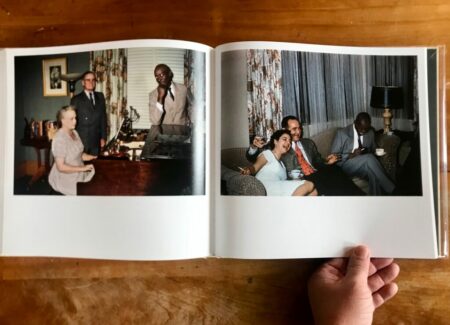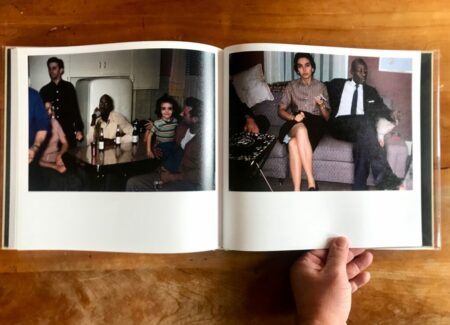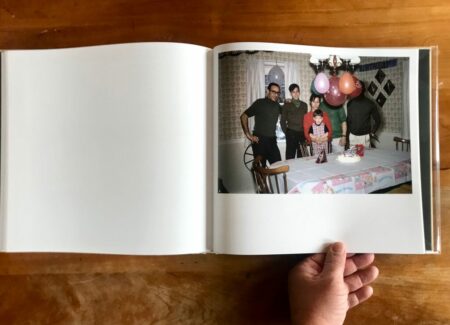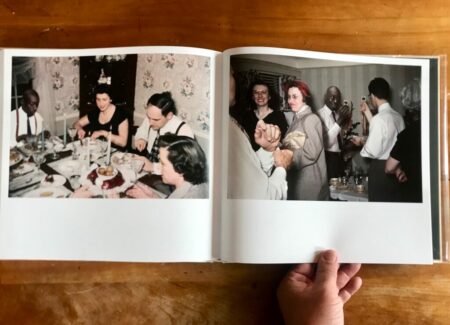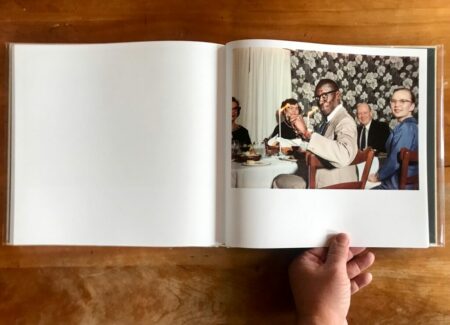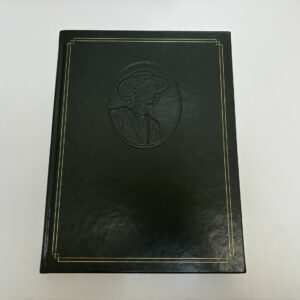JTF (just the facts): Published in 2023 by Editions Textual (here). Hardcover with tipped in cover photograph, 29 x 27 cm, 104 pages, with 55 color photographs. Includes an essay by Taous Dahmani, and a conversation between Lee Shulman & Omar Victor Diop, recorded by Marianne Théry and Manon Lenoir. Texts in French/English. Design by Agnès Dahan Studio. (Cover and spread shots below.)
Comments/Context: The Senegalese photographer Omar Victor Diop has built a formidable career out of role-playing. After a few early projects honing his studio portraiture skills on others, Diop has turned the lens on himself of late. Perhaps selves is a better word. Like a Hollywood character actor, he’s been cast in a range of parts: wax dolls, environmentalist mise-en-scènes, Black protests, baroque paintings, and more. Three of these projects—”Allegoria” (2021), “Liberty” (2017), and “Diaspora” (2014)—were collected in his eponymous debut monograph (reviewed here). Although Diop is the central figure in that book, its subtext was sociological. Interjecting a contemporary Senegalese man into historical backdrops might have been a blunt tool, but it was a surefire conversation starter, and a potential catalyst for rapidly shifting cultural norms.
Diop has twisted himself into so many personas that the real man is lost in the mix. Some brief background: He was born in Dakar, Senegal in 1980, the youngest of six kids. Diop expressed an early aptitude for the arts but his parents had other ideas. They shipped him off to Paris, where he trained for a short-lived career in corporate communications. After working a few years for multinationals in both Paris and Dakar, he eventually found his way back to the arts, photography to be precise. Inspired by Mama Casset, Seydou Keïta, Malick Sidibé, and the rich tradition of African portraiture, he specialized in studio work and gradually earned commercial clients and jobs in fashion and advertising. An invitation to the biennial Rencontres de Bamako 2011 put him on the African photo map, and the rest is history, more or less. Diop has shown at Paris Photo and the Rencontres d’Arles. His photos are a mainstay in international magazines and editorial work. His star is rising.
As all this was happening, Lee Shulman was launching a separate photographic endeavor in the UK. A self described “obsessive collector”, Shulman began acquiring Kodachromes in 2017. One thing led to another. People sent him their family heirlooms from every corner of the globe, in the form of small domestic windows framed in plastic slides. Within a few short years he’d built a collection of 800,000 photographs and co-founded a non-profit to organize, scan, and archive it all. The Anonymous Project has developed rapidly, and Shulman has curated found slides in surprisingly varied ways recently, for example juxtaposed with Martin Parr’s photographs and Justine Levy’s texts.
The Anonymous Project’s latest project Being There is a collaboration with Diop. As with much of Diop’s oeuvre, he casts himself here in a beguiling variety of costumes, poses, and characters. Each role fits like a glove into a particular background photo supplied by Shulman, chosen from North American snapshots made in the 1950s and 1960s. Like the old Reese’s ads, worlds collide in each picture. A young African man plucked out of context and plopped into post-war lily-white vacations: cultural historians can see where this is going already, and the photo combinations are as just jarring and hilarious as one might expect. Many are laugh-out-loud funny. But this photobook operates at a serious level too. In fact it’s one of the sharpest social commentaries I’ve encountered in any recent monograph.
At first glance these appear to be typical vacation pictures. They are point-n-shoot mugs with amateur framing and focus. We see the Grand Canyon, beach waves, and a trip to the zoo. But something is off. It doesn’t take long to notice the same peculiar character in every photo. After we realize he’s been artificially supplanted, Diop becomes the book’s driving force. He is in on the joke, smiling mischievously back at the reader in one unlikely scenario after another. Since these are quick wish-you-were-here tourist snaps, his gaze fits the mood perfectly. Of course he’s looking back at the photographer. That’s what you do on on family trips. Smile and say cheese.
Diop’s interjections come across as a grand inside joke. We get to laugh with him, not at him. Meanwhile it’s the Ozzie and Harriet scenery—looking threadbare, dated, and eerily familiar—which becomes the comic target. There’s Diop holding a shovel near freshly cleared sidewalk, standing proudly near his bouffant wife and white siding. His home is his castle. A few pages later he pops up on the archery course with friends in rolled up jeans and turtleneck. It’s been a pleasure, guys, and the arrows have found their target. Someone hand him a Pabst already. Other photos capture Diop relaxing in lawn chairs, picnicking in a field, toasting a cocktail party, and reading the paper in the den, among other leisure activities. It’s the pre-Sputnik glory days. No one seems in much of a hurry. Progress is not just inevitable but a birthright. The photos trace a greatest hits parade through halcyon America, at least as portrayed in pop culture imagery.
Romanticized history provides the book’s other driving force, for Shulman’s curation isn’t random. The photos were carefully selected to reflect a white nostalgic fantasy. Family snaps—and conceptions of domestic identity— took their unconscious cues from TV shows, magazines, and films of the time. Since those outlets typically excised Black culture, contemporaneous vacation slides naturally followed suit. Surely some representations of Black life were captured on slide film, and eventually found their way to Shulman’s desk. But for the purposes of this book they’ve been rendered invisible. Instead, Diop’s characters perform on Velveeta stages. His presence puts the exclamation point in every spread. Is it really possible, the reader wonders, that a public pool could entertain two hundred people and not include one Black person? After spending a few minutes scouting the faces, that fact becomes seems depressingly clear. If it’s any consolation, we eventually find Diop in the scene, engaged in conversation with two white buddies. It’s anyone’s guess what they’re discussing. Caucasian oligarchies, perhaps?
Shulman’s slides may be dated, but this book is cutting edge. Technically speaking it’s a modern marvel. Diop’s poses are precisely lit, choreographed, toned, and sized. As thespian roles they’re as carefully orchestrated as Cindy Sherman’s Untitled Film Stills. But with digital collage Diop takes them one step further. New and old shadows, costumes, props, and colorcasts blend seamlessly, even down to material flaws. Pixel peepers may find small discontinuities here and there, but only with effort. Most are perfect. A transcribed conversation with Diop and Shulman details the methodology. Suffice to say it’s the paramount of blending technique, and it makes Being There quite contemporary. Such montages would have been a practical challenge 10 or even 5 years ago.
But let’s not get hung up on technicalities. This is primarily a book of self-actualization. “It’s a way of projecting myself into worlds that aren’t necessarily accessible to me,” says Diop, a blunt appeal to inclusivity. Of course photographers have been projecting themselves into various worlds for decades. They percolated initially in the seventies me generation, then continued through Sherman, Nikki S Lee, Gillian Wearing, Samuel Fosso, Yasumasa Morimura, and Gordon Stettinius, to name just a few.
In the current era of reclaimed identity and expanded representation, role-playing self portraiture has assumed a fraught dimension. Shifting cultural mores come to a head in Being There, which seems ideally positioned to lay down a marker. Out with the bubbled past, in with global citizenry. Change is coming, but the MAGA contingent needn’t stress. It turns out the ride can be enjoyed. Being There is a rare photobook combination. With interesting pictures and strong political message, it’s a shot across the cultural bow. But the cannon fire feels light and absurd. It’s so well camouflaged that you might not notice the old warhorse sinking.
Collector’s POV: Omar Victor Diop is represented by Magnin-A Gallery in Paris (here). His work has not yet consistently found its way to the secondary markets, so gallery retail likely remains the best option for those collectors interested in following up.
